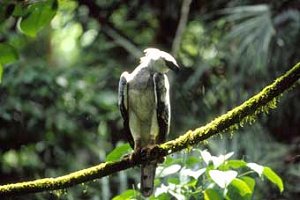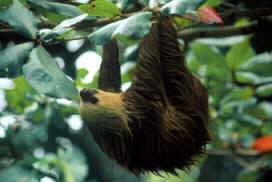|
Notes from the Field Harpy Eagle Releases in Panama |
|
Talented Huntress
August 2001
MV, a young female Harpy Eagle, gets her name from letters engraved in a metallic blue band on her left leg. She hatched January 16, 1998 at the Zoological Society of San Diego and was reared there until April 1998, when she was transferred to the World Center for Birds of Prey in Boise. At the World Center she was puppet-reared and also spent time with an adult female Harpy Eagle. In August 1998, MV was transferred to an enclosure in Panama’s Soberania National Forest for hack and release. Within a year she had captured her first Three-toed Sloth despite her lack of parental guidance. After dispersing far from her hack site, MV was relocated to The Smithsonian Tropical Research Institute’s Barro Colorado Island (BCI) in October 1999 following the relocation of James, another young captive-bred Harpy Eagle. BCI was the ideal location for the eagles’ release because it is a research sanctuary highly protected by game wardens and ecological police. Additionally, long-term research supported by the Smithsonian’s well-established facilities on the island provides readily available data such as population numbers of other species present.
MV showed what a talented huntress she was on BCI. We were able to watch her daily to observe her behavior. Latest research results have shown that she primarily forages on Three-toed Sloths and Howler Monkeys. She uses very different attack strategies for both of these species. More time is taken for capturing a sloth, often with several attempts from short distances as they are generally hidden deep within a tree crown. MV is quicker when attacking a Howler Monkey. Because they live in a troop, there are more eyes to see her with, which makes it pertinent that she catch her monkey of choice on her first try. If she misses her chance the large male Howler Monkeys of the troop chase her away and she then has to find a new monkey troop.
We also saw noteable hunting patterns, such as a tendency to successfully hunt Howler Monkeys more in the rainy season (May-December) and Three-toed Sloths more during the dry season and times of bright sunshine. MV hunted and killed prey every four days on average, and between kills we watched her rest, play with large fruits and epiphytes, and bath in streams, rain showers, and wet leafy treetops.
We observed MV for more than a year on Barro Colorado Island. Despite abundant prey and suitable habitat, she crossed to the mainland at its nearest approach twice in the autumn of 2000, and left the sanctuary of the Barro Colorado Nature Monument each time. The unfortunate death of James in a location not far off MV’s apparent path (see supporting Notes from the Field), as well as her prolonged stay in teak reforestation plantations with diminished prey populations, warranted intense concern for her safety each time she left BCI.
Tracking MV became a form of stewardship as much as a research activity. We adjusted to her wandering by watching her particularly closely and explaining her presence to communities and families she approached. Despite concern, we saw that she could hunt efficiently in her new surroundings; she continued to capture sloths and monkeys in small forest patches and she added two new prey items—an Armadillo and a Silky Anteater—to her prey list. But each time she left Barro Colorado, we trapped her for return and release as soon as she neared particularly dangerous areas.
In December of 2000, MV left Barro Colorado a third time. She may have continued to wander from Barro Colorado because of the dispersal impulse common to many young animals; alternatively, she may have left because she has been nearing sexual maturity and sought to encounter a male. Whatever the case, she took an indirect route to the dredging division of Gamboa, half-way down the Canal to Panama City, from her original position on Barro Colorado. Because of high poaching rates and large populations not yet reached by our education program, MV was trapped and brought back into captivity in April 2001. She is now housed in a newly constructed aviary at the Neotropical Raptor Center in the City of Knowledge, outside Panama City. We hope to release MV with a potential mate in the near future, in order that we may continue observation of this wonderful bird to understand how best to return to the wild eagles raised in captivity. By Janneene Touchton
| ||||||||||||||||||

